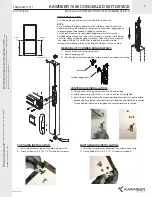
111
•
Folder:
Logic group combining
users, doors and virtual devices in
order to depict project circumstances
comprising room-based, rights-based
or organizationally-based groups
(e.g. building with several companies
or residential units – every company
or residential unit is collated as a
sub-folder and contains the rele
-
vant users and their devices).
User
rights in the Access System are
arranged on the basis of folders.
Logical separations between users
must be carried out using different
folders and user rights restrictions.
Important:
No matter which posi
-
tion it assumes in the project folder
structure,
every folder
must be
viewed as independent and in iso
-
lation from the others and can be
assigned the access rights
Visible
and
Switchable
for any other folder
and subfolder, irrespective of how
higher-level folders and subfolders
have been configured and the posi
-
tion assumed by the folder in the
project structure. However, already
performed user rights settings from
a higher-level folder are copied once
only from a higher-level folder to the
subfolder if this is created as a direct
subfolder of this higher-lever folder.
When moving a folder, the configu
-
ration always remains unchanged.
•
Users:
Logic group combining
devices in order to summarize and
depict the availability of a person
(e.g. 1 employee can be reached
by video panel, app for iPhone and
SIP video telephone) and in order to
maintain synchronicity of important
functions.
However, a user without assigned
Devices
can
not
be called, even
though a user call number exists in
the Access system.
Please note:
Maximum only one
software client (Access in-house tele
-
phone or Access concierge) and one
app (app for iPhone or app for iPad)
can be assigned to each user. If a
user requires two apps, for example,
you must create a separate user for
each app and form a call group from
these users.
•
Door:
Door station located at an
access or passageway of a property
which has a door (e.g. door station
at the entrance door). Every door
station requires an Access door
loudspeaker controller (ATLC) which
is automatically recognized by the
Access system.
•
Device:
Hardware and/or soft
-
ware-based communication unit
which can be used in conjunction
with the Access server for com
-
munication inside and outside the
Access system (e.g. Access in-house
telephone video, Siedle app for the
iPhone or iPad).
•
Virtual Device:
Switching and
control device connected via a
gateway to the Access server which
can be remotely activated using a
configured device (e.g. binary KNX
switching device).
Differentiation between users
and call groups
A user can comprise one or more
devices. A call group comprises one
or more users which in turn can con
-
tain one or more devices. As central
functions of the Access system fall
within the jurisdiction of the users
and the devices can only access
these, the following characteristics
(e.g. different behaviour patterns)
must be observed:
•
Video memory:
All users have
their own central video memory.
All devices assigned to a user may
access it. If an image is deleted by
one device, the image is deleted for
the user and is no longer available
for this user’s other devices.
•
Call group:
In the case of a call
group, several users exist and there
-
fore several video memories. If there
is a door call to a call group, an
image is saved in the video memory
of all users with an activated auto
-
matic video memory. The door call
image is thus stored on several
video memories. If such an image is
then deleted by a device, this image
is only deleted for its users and it
remains available in the video mem
-
ories of the other users.
•
Call log:
The same behaviour as
for the video memory, as the call
list lies within the jurisdiction of the
user/users -> Call groups therefore
have several decentral call logs
which are not synchronized.
•
Rejected calls:
If a user with
several assigned devices is called
and if the call is rejected by one of
this user's devices, the calls to the
remaining devices of this user are
terminated. If a call group with sev
-
eral assigned users is called and the
call is rejected by one of the user's
devices, the calls to the remaining
devices of this user are terminated,
but the call to other users of this
call group is retained and can be
accepted by any optional device.
















































